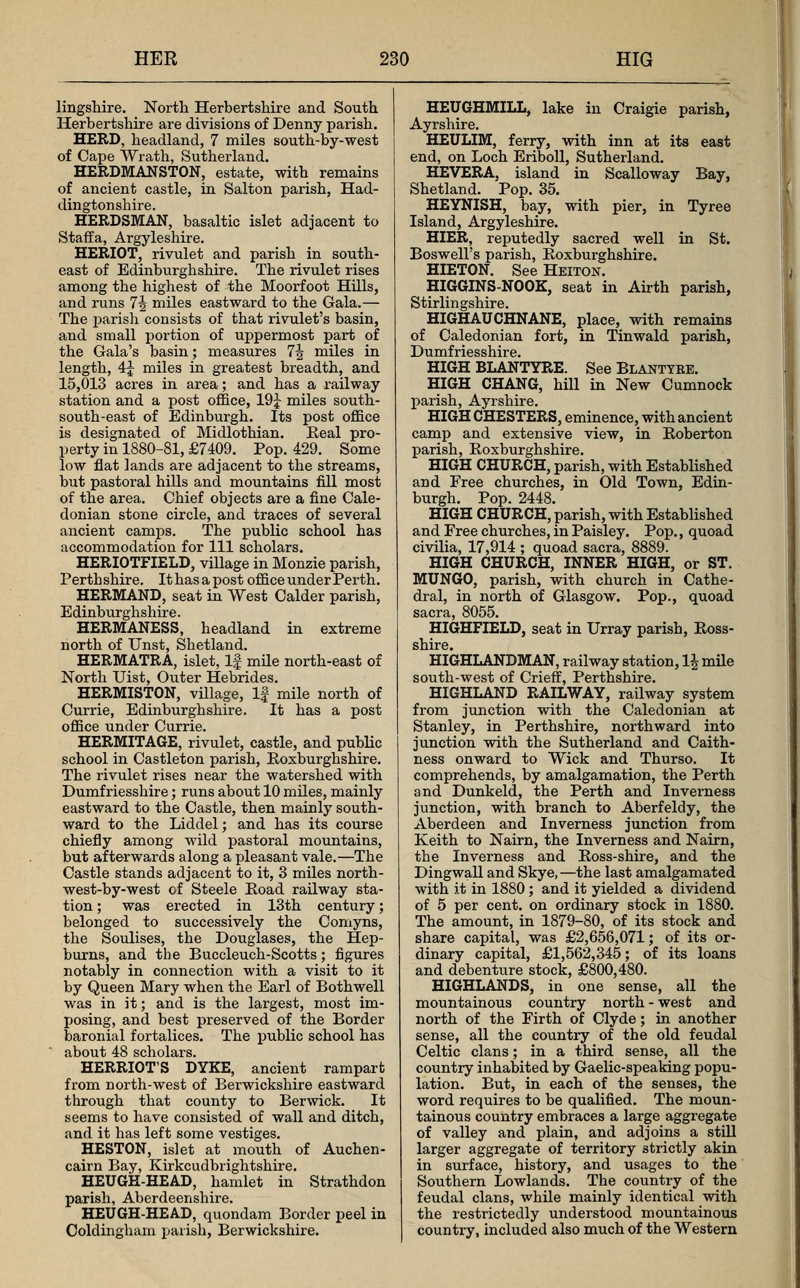HERD, headland, 7 miles south-by-west of Cape Wrath, Sutherland.
HERDMANSTON, estate, with remains of ancient castle, in Salton parish, Haddingtonshire.
HERDSMAN, basaltic islet adjacent to Staffa, Argyleshire.
HERIOT, rivulet and parish in south-east of Edinburghshire. The rivulet rises among the highest of the Moorfoot Hills, and runs 7J miles eastward to the Gala. The parish consists of that rivulet's basin, and small portion of uppermost part of the Gala's basin; measures 7J miles in length, 4| miles in greatest breadth, and 15,013 acres in area ; and has a railway station and a post office, 19 miles south-south-east of Edinburgh. Its post office is designated of Midlothian. Eeal property in 1880-81, 7409. Pop. 429. Some low flat lands are adjacent to the streams, but pastoral hills and mountains fill most of the area. Chief objects are a fine Cale-donian stone circle, and traces of several ancient camps. The public school has accommodation for 111 scholars.
HERIOTFIELD, village in Monzie parish, Perthshire. It has a post office under Perth.
HERMAND, seat in West Calder parish, Edinburghshire .
HERMANESS, headland in extreme north of Unst, Shetland.
HERMATRA, islet, If mile north-east of North Uist, Outer Hebrides.
HERMISTON, village, If mile north of Currie, Edinburghshire. It has a post office under Currie.
HERMITAGE, rivulet, castle, and public school in Castleton parish, Roxburghshire. The rivulet rises near the watershed with Dumfriesshire ; runs about 10 miles, mainly eastward to the Castle, then mainly south-ward to the Liddel; and has its course chiefly among wild pastoral mountains, but afterwards along a pleasant vale. The Castle stands adjacent to it, 3 miles north-west-by-west of Steele Road railway station; was erected in 13th century; belonged to successively the Comyns, the Soulises, the Douglases, the Hep-burns, and the Buccleuch-Scotts ; figures notably in connection with a visit to it by Queen Mary when the Earl of Bothwell was in it ; and is the largest, most im-C'ng, and best preserved of the Border mial fortalices. The public school has about 48 scholars.
HERRIOT'S DYKE, ancient ramparfc from north-west of Berwickshire eastward through that county to Berwick. It seems to have consisted of wall and ditch, and it has left some vestiges.
HESTON, islet at mouth of Auchencairn Bay, Kirkcudbrightshire.
HEUGH-HEAD, hamlet in Strathdon parish, Aberdeenshire.
HEUGH-HEAD, quondam Border peel in Coldingham parish, Berwickshire.
HEUGHMILL, lake in Craigie parish, Ayrshire.
HEULIM, ferry, with inn at its east end, on Loch Eriboll, Sutherland.
HEVERA, island in Scalloway Bay, Shetland. Pop. 35.
HEYNISH, bay, with pier, in Tyree Island, Argyleshire.
HIER, reputedly sacred well in St. Boswell's parish, Roxburghshire.
HIETON.
HIGGINS-NOOK, seat in Airth parish, Stirlingshire.
HIGHAUCHNANE, place, with remains of Caledonian fort, in Tinwald parish, Dumfriesshire.
HIGH BLANTYRE.
HIGH CHANG, hill in New Cumnock parish, Ayrshire.
HIGHCHESTERS, eminence, with ancient camp and extensive view, in Roberton parish, Roxburghshire.
HIGH CHURCH, parish, with Established and Free churches, in Old Town, Edinburgh. Pop. 2448.
HIGH CHURCH, parish, with Established and Free churches, in Paisley. Pop. , quoad civilia, 17,914 ; quoad sacra, 8889.
HIGH CHURCH, INNER HIGH, or ST. MUNGO, parish, with church in Cathedral, in north of Glasgow. Pop., quoad sacra, 8055.
HIGHFIELD, seat in Urray parish, Ross-shire.
HIGHLANDMAN, railway station, 1 \ mile south-west of Crieif, Perthshire.
HIGHLAND RAILWAY, railway system from junction with the Caledonian at Stanley, in Perthshire, northward into junction with the Sutherland and Caithness onward to Wick and Thurso. It comprehends, by amalgamation, the Perth and Dunkeld, the Perth and Inverness junction, with branch to Aberfeldy, the Aberdeen and Inverness junction from Keith to Nairn, the Inverness and Nairn, the Inverness and Ross-shire, and the Dingwall and Skye, the last amalgamated with it in 1880 ; and it yielded a dividend of 5 per cent, on ordinary stock in 1880. The amount, in 1879-80, of its stock and share capital, was 2,656,071 ; of its ordinary capital, 1,562,345; of its loans and debenture stock, 800,480.
HIGHLANDS, in one sense, all the mountainous country north-west and north of the Firth of Clyde ; in another sense, all the country of the old feudal Celtic clans ; in a third sense, all the country inhabited by Gaelic-speaking population. But, in each of the senses, the word requires to be qualified. The mountainous country embraces a large aggregate of valley and plain, and adjoins a still larger aggregate of territory strictly akin in surface, history, and usages to the Southern Lowlands. The country of the feudal clans, while mainly identical with the restrictedly understood mountainous country, included also much of the Western Islands which had a different history, and are not usually regarded as part of the Highlands, but bear the separate name of Hebrides. The country of the Gaelic-speaking population has, in modern times, become greatly curtailed both by native adoption of the English language and by extensive settlement within it of the Scoto-Saxon race. The name Highlands is thus exceedingly indefinite ; and yet, in a loose large sense, aptly designates a vast region on and beyond the Grampians, exhibiting mixed features of wildness, beauty, and sublimity.

